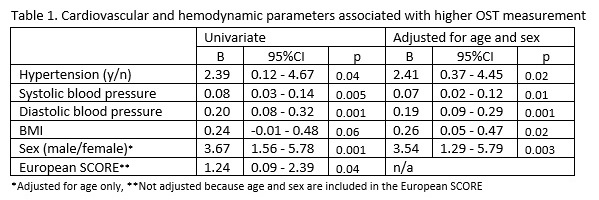Session Information
Session Type: Poster Session D
Session Time: 9:00AM-11:00AM
Background/Purpose: Optical spectral transmission imaging (OST) is a new imaging method designed to measure inflammation in the hands of rheumatoid arthritis (RA) patients. The device uses a pressure cuff to occlude venous blood flow, resulting in an increased blood pool in the hands of the patient. In inflamed joints transmission of light through this blood pool is altered due to higher blood content, lower oxygenation and stronger hemodynamics at the location of inflammation. However, altered hemodynamics not related to inflammatory arthritis might also influence OST measurements. In this study we investigated whether hemodynamic and other cardiovascular parameters affect OST in healthy participants.
Methods: OST measurement was done in 37 healthy participants using the HandScan device (Hemics, the Netherlands). Carotid intima media thickness (IMT), pulse wave velocity (PWV) and augmentation index (AIx) were measured with ultrasound and SphygmoCor tonometry. Age, sex, diastolic and systolic blood pressure, pulse, hypertension (defined as systolic blood pressure >140 mmHg or diastolic blood pressure > 90 mmHg or antihypertensive treatment), total cholesterol, HDL, LDL, total/HDL cholesterol ratio, body mass index (BMI), European SCORE risk assessment, smoking status, cardiovascular history and medication use were collected during the same visit. Associations were investigated using univariate linear regression and multivariate regression adjusting for age and sex.
Results: Participants were 53 ± 8 years old and 65% was female. Systolic and diastolic blood pressure was 129 ± 19 mmHg and 80 ± 9 mmHg respectively and 22% used antihypertensive treatment, 8% an anticoagulant and 11% a statin. In total 38% had hypertension and 8% had a history of cardiovascular disease.
Mean OST value was 12.69 ± 3.47 and all values were between 5.00 and 20.78. Cardiovascular and hemodynamic parameters that were associated with higher OST measurement were: hypertension (14.18 ± 1.12 versus 11.79 ± 0.69), systolic and diastole blood pressure, BMI and European SCORE (table 1). Also, male sex was associated with a higher OST with and without adjustment for age (15.05 ± 1.04 versus 11.41 ± 0.62 for females). Other parameters (age, cholesterol, pulse, IMT, having carotid plaque, PWV, AI, cardiovascular history, smoking status and statin, antihypertensive drug and/or anticoagulant use) were not associated with the OST measurement (p >0.13).
Excluding the 5 (14%) participants with hand osteoarthritis showed comparable results, except for BMI and hypertension. BMI was also significantly associated with OST in the univariate analysis (B 0.24, 95%CI 0.01-0.47, p=0.039), while hypertension lost its statistical significance (uni B 1.74, 95%CI -0.69-4.17, p=0.15; multi B 1.44, 95%CI -0.61-3.48, p=0.16).
Conclusion: High blood pressure, BMI, male sex and European SCORE are associated with increased OST values in healthy participants. This indicates that differences in OST measurements of RA patients might not only reflect inflammatory burden but is also dependent on sex, blood pressure and body composition. This should be taken into account when using optical spectral transmission imaging for the assessment of inflammation in RA patients.
To cite this abstract in AMA style:
Blanken A, van der Laken C, Nurmohamed M. Blood Pressure, BMI and Sex Affect Optical Spectral Transmission Imaging Measurements of the Hands [abstract]. Arthritis Rheumatol. 2020; 72 (suppl 10). https://acrabstracts.org/abstract/blood-pressure-bmi-and-sex-affect-optical-spectral-transmission-imaging-measurements-of-the-hands/. Accessed .« Back to ACR Convergence 2020
ACR Meeting Abstracts - https://acrabstracts.org/abstract/blood-pressure-bmi-and-sex-affect-optical-spectral-transmission-imaging-measurements-of-the-hands/

